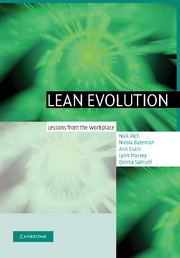Book contents
- Frontmatter
- Contents
- List of boxes
- List of figures
- List of tables
- Glossary
- 1 Introduction
- 2 Understanding the lean journey
- 3 Understanding your organisation
- 4 Laying the foundation stone of CANDO
- 5 Visual management and performance measurement
- 6 Problem solving, TQM and Six Sigma
- 7 Pull systems
- 8 Total productive manufacturing (TPM)
- 9 Sustainability
- 10 Group learning
- 11 Reflections and future challenges
- References
- Index
7 - Pull systems
Published online by Cambridge University Press: 17 August 2009
- Frontmatter
- Contents
- List of boxes
- List of figures
- List of tables
- Glossary
- 1 Introduction
- 2 Understanding the lean journey
- 3 Understanding your organisation
- 4 Laying the foundation stone of CANDO
- 5 Visual management and performance measurement
- 6 Problem solving, TQM and Six Sigma
- 7 Pull systems
- 8 Total productive manufacturing (TPM)
- 9 Sustainability
- 10 Group learning
- 11 Reflections and future challenges
- References
- Index
Summary
Introduction
The origin and at the very core of lean enterprise lies the design of the Toyota production system (TPS) and its ability to flow products through a low buffered manufacturing process (Womack et al., 1990). On first encountering the approach to systematically designing a high-performance production system, it appears counter-intuitive to many and a long way away from the Western traditions that have been dominated by mass production thinking (Womack and Jones, 1996). However, the ‘system’ design combines a number of key features which support customer service and the compression of time between receiving goods and receiving payment for the conversion process (Mather, 1988). This chapter will examine the basic elements of the ‘pull’ systems of a lean enterprise and explore alternatives for businesses that do not conform to the ‘high volume–standard product’ environment of automotive component manufacturing and assembly.
Production scheduling
The history of production scheduling in the West began with the use of clerical workers to schedule manually the complex products and the manufacturing/assembly processes so that products were outputted into the finished good stores just as customer due dates for orders were reached. In essence these planners attempted to launch production in time for when the customer expected delivery, but there were many aspects of traditional and mass production approaches which complicated even the most simple of manufacturing processes. These features included a core belief that batch production was the answer to cost efficiency (and therefore profit maximisation).
Information
- Type
- Chapter
- Information
- Lean EvolutionLessons from the Workplace, pp. 122 - 140Publisher: Cambridge University PressPrint publication year: 2006
